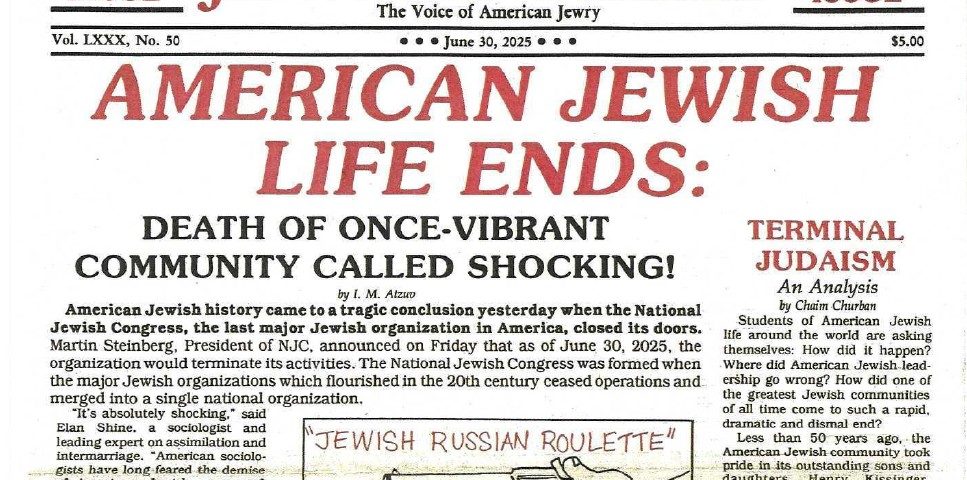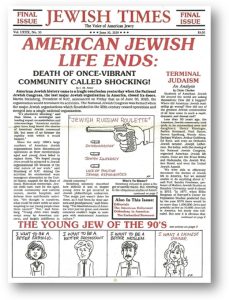TRADITION Questions: Of Prophets and Critics

Click here to read about the TRADITION Questions series, which goes on hiatus after this week’s column. Chaim Strauchler will return to TraditionOnline.org in September with new installments of his The BEST (read about that series here).

“Jewish Times (June 30, 2025),” courtesy of NJOP. Click image to access the full issue (published in 1992).
What is it?
In October 1992, the National Jewish Outreach Program (NJOP) published a four-page broadsheet postdated to June 30, 2025. Taking the name Jewish Times, the paper’s “final issue” futurecasts a community’s doom with a banner headline in red, AMERICAN JEWISH LIFE ENDS. The first sentence reads, “American Jewish history came to a tragic conclusion yesterday when the National Jewish Congress, the last major Jewish organization in America, closed its doors.”
Next Monday, American Jewish life will likely stumble along in all its glory along with its many organizations. Yet, this time capsule is worth examination. What did the prognosticators get right and what did they get wrong? What value do its warnings still hold even as it passes its prophetic due date?
Why does it matter?
In May 2020, the Pew Research Center released a report that found that the American Jewish population is stable in percentage terms, while rising in absolute numbers. Yet the report described “two sharply divergent expressions of Jewishness”—one involving religion deeply enmeshed in every aspect of life, and the other involving little or no religion at all. Younger Jewish adults are more likely than older Jews to identify as Orthodox. Among Jews ages 18 to 29, 17% self-identify as Orthodox, compared with just 3% of Jews 65 and older. At the same time, 27% of American Jewish adults did not identify with the Jewish religion: They consider themselves to be Jewish ethnically, culturally, or by family background. Their number also increases among younger demographics. While not the end of American Jewish life, these numbers suggest the long decline of NJOP’s loosely affiliated “I want a Chinese dinner” Jew.
An article in the NJOP newspaper entitled “Terminal Judaism” singles out two factors in American Jewish decline: “Diversion of funds to other important causes [other than communal survival], and the lack of Jewish education which led to widespread devaluation of Judaism.” The authors call out a lack of significant organizational investment in Jewish education, “only $90.60 per child annually.” The critical role of Jewish education in Jewish continuity has proven correct, yet the conversation on the issue has shifted. While communities that have invested in Jewish education have thrived, existential discussions now center on the high cost of Jewish living and the resulting pressures toward higher-income professions (and the potential exclusion of those who can’t afford Jewish life).
The prophets of 1992 did not anticipate a resurgence of antisemitism and its effect on Jewish continuity. While Pew found that 75% of American Jews see antisemitism growing in the United States, just 5% of all U.S. Jews say that they have stayed away from a Jewish event as a result. While the newspaper (“A Meaningless ‘Never Again’”) bemoaned the lack of attention on the “internal” enemy as opposed to the “external” enemy, the renewed presence of external threats both before and after October 7 has brought many Jews together as Jews.
In an article entitled “Orthodoxy in America,” the authors imagine a future in which Orthodox institutions fail financially due to the absence of funding from non-Orthodox sources. “America began to decline as a Torah center. Orthodox communities began to amalgamate, as smaller and weaker Orthodox communities were forced to close.” The “surprising” economic strength of American Orthodoxy reflects both the blessing of America and an undervaluation of Orthodox prowess. Yet, not being dependent on the money of others also means that fewer connections take place and fewer relationships are formed. What effect does the decline in religious identification among the non-Orthodox have upon the Orthodox?
What questions remain?
The earliest appearance of the word “Israel” in the archeological record was the Merneptah Stele (Egypt 1213–1203 BCE). It reads, “Israel is laid waste—its seed is no more.” From its first appearance, the Jewish people were discounted, discredited, and dismissed. Jewish prophets have delivered their own dire warnings for the Jewish people. What is it about Jews and predictions of our annihilation?
The NJOP newspaper contains an advertisement at the end of its last page, “Enough is Enough! Jewish life in America must not be allowed to end in tragedy—you can make the difference!” This is obviously a fundraising pitch. What prophecies were not offered regarding Jewish outreach organizations themselves? What have been their successes and shortcomings?
“It is not the critic who counts,” said Theodore Roosevelt. The Jewish Times is a form of social criticism. The critic raises his or her head and asks questions. He or she calls out, “What’s going on here? What will we be in 33 years?” The critic is often the only one counting, checking, and questioning. As TRADITION Questions goes off on hiatus, let us proudly ask questions. And while we are prognosticating, TRADITION will release a podcast in the coming weeks reflecting on the messages explored in this project. Let’s see what happens.
Chaim Strauchler, rabbi of Rinat Yisrael in Teaneck, is an Associate Editor of TRADITION.
